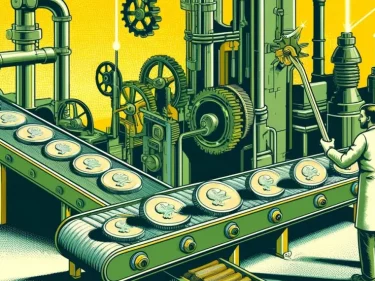Blockchain Game Shrapnel Aims for AAA Status in Web3

Shrapnel head of studio gives insights into the game’s economy.
- Shrapnel released the latest version of its white paper on Friday
- Players can mint and curate in-game NFTs and stake SHRAP tokens
Traditional AAA studios tend to keep everything in the dark until a project is deemed ready for its big reveal — not Neon Media, the publisher behind upcoming first-person shooter multiplayer Web3 game Shrapnel.
Top-tier video games usually take a long time and require a large budget to build — three to five years with an average cost of about $80 million.
The process to build blockchain-based video games, on the other hand, is different, Don Norbury, chief technology officer at Neon Media, told us.
Set in a dystopian world in the future, Shrapnel is currently being built on the Avalanche subnet and the Unreal 5 graphics game engine. What differentiates this game from other Web3 offerings is its level of community involvement and its distinct gaming finance (GameFi) mechanics, powered by NFTs.
The team behind Shrapnel, made up of entertainment veterans from HBO and Microsoft, have been working to include future players in the development of its gameplay, lore and NFT ecosystem.
For staff hailing from Web2 backgrounds, “engaging with the community, getting ideas back, sharing more than you traditionally would be comfortable sharing — just because you wanted to go through 18 iterations before it ever sees the light a day — has been tricky,” said Norbury, who is also the studio head for Shrapnel.
The game is currently in pre-alpha development. The team will be sharing early access versions with focus group participants to get feedback beginning next spring — so a full public release could still be years away.
Potential players have been able to purchase an Operator avatar NFT, which represents a mercenary character in the Shrapnel universe. Holders received digital and physical comic books created for each of the five available characters’ backstories at San Diego Comic-Con in July.
More recently, Shrapnel dropped a two-minute game trailer on Monday, similar to how a trailer is released in the lead up of a movie premiere.
Shrapnel to boast in-game crypto economy
Shrapnel also released the project’s white paper on Friday, outlining its tokenomics and in-game assets scheme.
The game itself is pitched to double as a platform for community-built maps with various sets of rules and gameplay styles, all based on a single-token economy based on SHRAP, an Avalanche-based governance token.
For what it’s worth, the trailer features a spacey character exploring a futuristic and dirty city, along with some gunplay. Stakeholders can fall into different categories — gamers, creators, curators and land owners.
Each user type can earn SHRAP rewards by completing missions, creating NFTs or staking their tokens to receive two types of NFTs — vanity items and maps. Vanity items include gear, weapons, cosmetics and skins.
Maps are divided between game areas known as The Arena and The Podium. Stakeholders aim to get their own or favorite maps to the middle of The Podium by advertising them. As maps gain popularity and SHRAP stakers, they increase in size and move closer to The Podium. Once in The Podium, players and stakers can partake in performance-based SHRAP incentives.
“We want the majority of the time people are playing Shrapnel to be on community maps, not the maps that we’re making,” Norbury said, adding that “a lot of the effort that we would be spending doing a narrative in a single-player campaign we’re spending on our tools pipeline.”
This rewards system requires dedication and skill to create high-quality maps that others will want to play, rather than just clicking-to-earn money. Any gas fees will be subsidized in the transaction fee.
Play-to-own
Shrapnel follows what it calls the play-to-own model.
This means that users effectively own the intellectual property (IP) for what they create and mint, but they are giving Shrapnel the license to use in-game, Norbury said about creating a “healthy-self sustainable ecosystem where people actually own and control the things they create.”
Shrapnel thus plans to attract and retain users via its content generation mechanism — finding, curating and promoting the best player-created vanity items and maps, as well as staking on them. A large user base would ensure a balanced supply and demand for SHRAP.
A token offering and the Shrapnel NFT marketplace are planned to launch within the next few months, according to Norbury.
The white paper stated that 3 billion SHRAP tokens will be created as the total token supply, which will never increase.The community will receive 33% of SHRAP tokens, 27% will be distributed to the team and its advisers, 20% will go to seed token holders and other stakeholders will receive the remaining 20%.
SHRAP utility includes voting rights on player-created content and on certain aspects of the Shrapnel protocol. Additionally, the team is still figuring out how validator nodes can take SHRAP as the gas token, subsidizing the gas fee to the end user.
The game will also build its own subnet for low latency. When asked why the AVAX subnet was chosen, Norbury listed the reasons of security, customizability, future proofing and computational power.
He also made the distinction between games like Axie Infinity that continuously require more people to come in in order to prop up the people that are already there.
“If you look at it from an economic perspective, there has to be a production principle to it. Something of value has to be produced, and then people have to desire or be willing to engage with it in various ways,” Norbury said.



